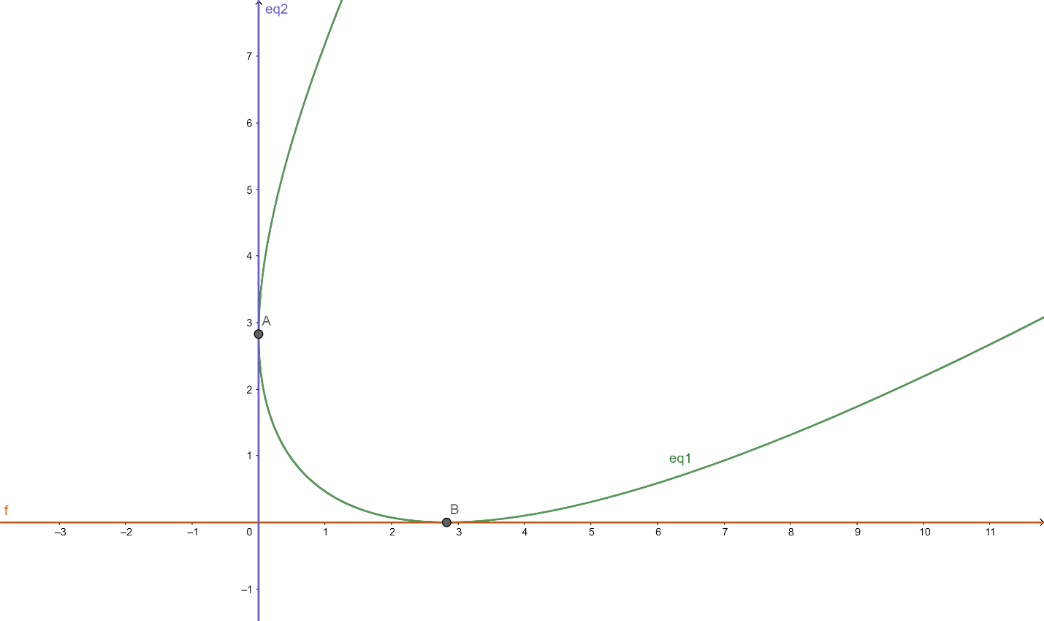Question
Question: If a parabola whose length of latus rectum is 4a touches both coordinate axis then find the locus of...
If a parabola whose length of latus rectum is 4a touches both coordinate axis then find the locus of its focus.
a) x2y2=a2(x2+y2)
b) x2y2=a2(x2−y2)
c) x2y2=a3(x3+y2)
d) None of these
Solution
Hint: Consider the point on parabola in the form of (at2,2at) and draw tangents to the parabola. Then, we can use the distance between focus given by (a,0) and tangents to formulate equations. The two tangents drawn to the parabola will be perpendicular to each other, so we can apply conditions for slopes of perpendicular lines to solve further.
Complete step-by-step solution -
It is given that the latus rectum is 4a. So, let the given parabola y2=4ax. Let the graph of parabola be like that which cuts both coordinates at A and B.

Let a point on parabola be (at2,2at). We have to find dxdy of the curve at a given point. Slope of tangent to given point (at2,2at) =dxdy.
y2=4ax
We know dxdxn=nxn−1, so we get
2ydxdy=4a
The given point is (at2,2at), so, y=2at
dxdy=2(2at)4adxdy=t1
So the slope of tangent passes through point (at2,2at) is =t1……(1)
Now, we can substitute the points and the slope write the equation of tangent using the formula y−y1=m(x−x1) as
y−2at=t1(x−at2)t(y−2at)=x−at2ty−2at2=x−at2x−ty+at2=0
Let A (as2,2as) be a point on the parabola, on the x-axis. So, from the above discussion and using equation (1), we can conclude that the slope of tangent passing through (as2,2as) is =s1. We can substitute it in the equation of tangent and we get x−sy+as2=0.
Now, we know the focus of parabola y2=4ax must be at (a,0). Then the distance of focus from the tangent of the equation x−sy+as2=0 can be calculated using the formula of distance of a point from line. If we have a line ax+by+c=0, then the perpendicular distance from a point (x,y) to line is given by d=a2+b2xa+yb+c.
Now let the distance from focus point (a,0) be x. Then we have,
x=12+s2a−0+as2x=12+s2a(1+s2)x=a12+s2………(2)
Similarly, let B (ar2,2ar) be a point on the parabola, on the y-axis. So, from the above discussion and using equation (1), we can conclude that the slope of tangent passing through (ar2,2ar) is =r1. We can substitute it in the equation of tangent and we get x−ry+ar2=0.
Similarly, we can find the distance from focus point (a,0) as y. So, we will get
y=12+r2a−0+ar2y=12+r2a(1+r2)y=a12+r2………(3)
Now, we know that the tangents are perpendicular to each other. So, the product of their slope is equal to -1. Applying it, we will get
r1×s1=−1
rs=−1………(4)
Now using equation (2), we get
ax=(12+s2)(ax)2=(12+s2)(ax)2−1=s2………(5)
Now using equation (3), we get
ay=(12+r2)(ay)2=(12+r2)(ay)2−1=r2………(6)
Multiplying equation (5) and (6), we get
((ay)2−1)((ax)2−1)=r2s2(a2y2−1)(a2x2−1)=r2s2
Now, simplifying terms inside bracket and using equation (4), we get
a2a2x2y2−a2x2−a2y2+1=(−1)2a4x2y2−a2(x2+y2)+1=1a4x2y2−a2(x2+y2)=0x2y2−a2(x2+y2)=0x2y2=a2(x2+y2)
A parabola whose length of latus rectum is 4a touches both coordinate axis then the locus of its focus is x2y2=a2(x2+y2).
So, the correct option must be a).
Note: Equation of a tangent to a parabola passing through point (at2,2at) can be taken as x−ty+at2=0 directly instead of deriving it. We must memorise this as it is very helpful in solving such questions and it will save time in the exam. In this question, latus rectum value is given through which we can find the focus of parabola and its equation.
